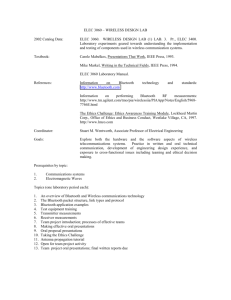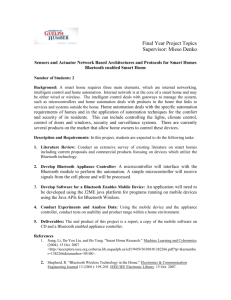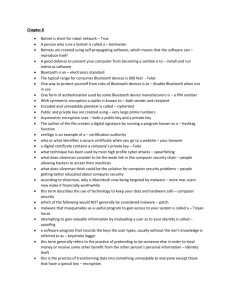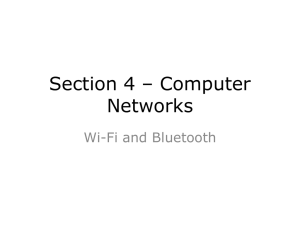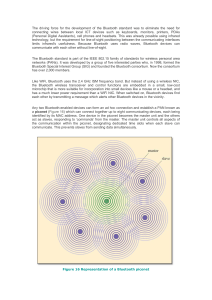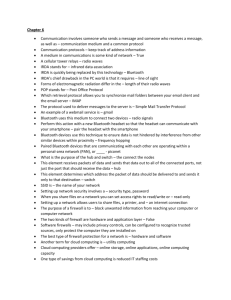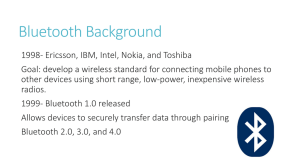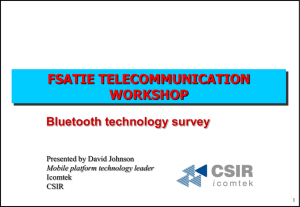Lecture 16: RFID and Bluetooth
advertisement
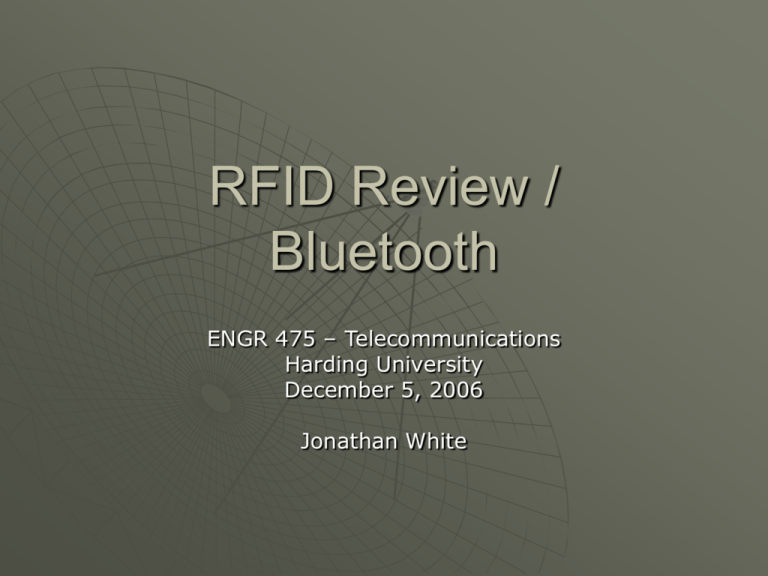
RFID Review / Bluetooth ENGR 475 – Telecommunications Harding University December 5, 2006 Jonathan White Outline What you need to know about RFID Bluetooth Applications Future Technical Specifications • Algorithms • Air Interface • Security Concerns RFID Review RFID – Radio Frequency Identification. Idea: • Use low cost tags to identify objects Benefits: • Line of sight isn’t required (as in UPC Codes). • Much faster inventorying of objects. • Enables each item to be uniquely identified. RFID Review 3 types of tags: • Active: Have a battery, are always able to transmit and receive, very large, long range, very expensive. Example: Airplane controllers • Semi-Active: Have a battery, but they only transmit when in an RF field. They are large and fairly expensive. Example: Toll tags • Passive: No battery, receive power from only the RF field, very small, very cheap, small range. Example: Entry key fobs, Exxon SpeedPass, EPCGlobal tags. EPC Electronic Product Code. • A replacement for UPC • Has all the data of a UPC plus other fields. • Some fields can be used to store variables. • Some fields can be used to uniquely identify each object. • Many interesting applications. EPC Details Low Range: 20 feet Low Cost: 5 cents Low Power requirements: • Near field: Under 10 cm or so, tag acts like the opposite side of a transformer, and it can receive more power. • Far field: From .5 feet to 20 feet, tag uses backscattering to reflect a modulated RF field to the receiver. Operates in the 900 MHz region. • Unlicensed, limited by the government. Bluetooth Designed in Sweden in 1994. The goal was to design one interface for devices to connect and exchange information wirelessly. • This would aid in the elimination of all the cables that are proliferating all around us. • Not designed to provide power, however. • Also, Bluetooth was originally designed to be short range and secure, but this is not necessarily true now. Bluetooth Applications Wireless Cell phone handsets Wireless controllers (Wii) Wireless computer connections • Most common: keyboard, mouse, printer For remote controls where IR was used. • Better range and accuracy. PDA’s, Calculators Transfer of files in an Ad Hoc Network. • If you don’t have a WiFi network available. Bluetooth Applications Future of Bluetooth Bluetooth has a good future: • Data rates of 3 Mbps • Better security • Better range. This will allow Bluetooth TVs and video projectors. The goal is to make an unwired society. • But, you still need power. Technical Specs Bluetooth operates in the 2.4 GHz range. • Unlicensed, same band that certain wireless phones, garage door openers, and baby monitors use. Bluetooth devices typically operate at around .1 Watts. • Much less than the 3 Watts that a typical cell phone operates at. Maximum range is supposed to 100 meters. • This can be extended to a mile with antennas. Technical Specs Bluetooth can connect up to 8 devices. • 1 master, 7 slaves with about a 10 meter radius. Bluetooth uses spread spectrum frequency hopping. • There are 79 potential frequencies a device can transmit on, so this should help eliminate collisions. Technical Specs Devices constantly scan for a new Bluetooth connection. • This lets them know what master is controlling them, and whether or not another device should be added to the group. Since this connection is automatic, security is a large problem for Bluetooth. • Bluetooth viruses, bluejacking, blue bugging. Conclusion The use of Bluetooth will be expanded in the coming years. Good for a wire replacement. It won’t replace WiFi or cellular networks. • It’s impact on Telecommunications is very secondary.


